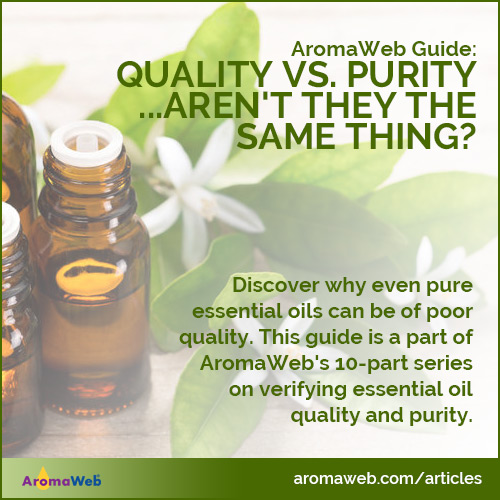Quality vs. Purity - Aren't They the Same Thing?
An essential oil can be pure while also being of poor quality. By holistic aromatherapy standards, an oil that is not pure is clearly considered of poor quality.
What Affects the Quality of Essential Oils?
The aroma and exact percentage of each natural constituent contained in a particular pure, unadulterated essential oil can very depending on a variety of factors:
- Quality of the soil the botanical is grown in
- The amount of rainfall
- The temperature/climate
- The altitude
- The way the botanical is harvested
- The way the botanical is stored prior to distillation
- The length of time that passes between when the botanical was harvested and when it is distilled into an essential oil
- The exact part of the plant used in the distillation of the oil
- The type of distillation equipment being used including the material it is made out of (i.e. copper vs. steel components)
- The storage conditions of the essential oil
- Any adulteration, tampering or contamination of the essential oil
What Affects the Purity of Essential Oils? How are Essential Oils Usually Adulterated?
An adulterated essential oil is one that has been tampered with in some way. The common ways that essential oils are adulterated are as follows:
- Blending/combining other less expensive essential oils and fraudulently marketing the oil as a pure, more costly oil. (i.e. the Yuzu essential oil example mentioned previously)
- Blending a higher quality essential oil with a lower quality version of the same species
- Adding individual constituents, whether naturally or synthetically derived, to an essential oil
- Adding synthetics to improve the aroma
- Mishandling or improper packaging of an essential oil. For example, if a supplier reuses pouring bottles used to decant essential oils into smaller bottles, this could contaminate the essential oil with another species of oil.
- Adding vegetable (carrier) oils and not disclosing the dilution to the end consumer (This can often be detected by the consumer by simply placing several drops of the oil on a tissue or perfumery blotter and waiting for the oil to dry out. If an oily ring remains, it may indicate that the essential oil has been diluted in a vegetable oil.
This topic consists of several separate related articles. Use the links shown below to navigate through the series.
Next: Part 6: Quantifiable Testing of Essential Oils
- Part 1: Introduction
- Part 2: Why Is the Quality/Purity of an Essential Oil Important?
- Part 3: Aren't Most Essential Oils Pure?
- Part 4: Constituents - What do Essential Oils Consist Of?
- Part 5: Quality vs. Purity - Aren't They the Same Thing?
- Part 6: Quantifiable Testing of Essential Oils
- Part 7: GC-MS and GC-FID Test Results: How to Understand and Use Them
- Part 8: Organoleptic Testing of Essential Oils
- Part 9: Other Quantifiable Tests for Testing the Quality and Purity of Essential Oils
- Part 10: Essential Oil Quality and Purity Conclusion: Final Questions/Answers
